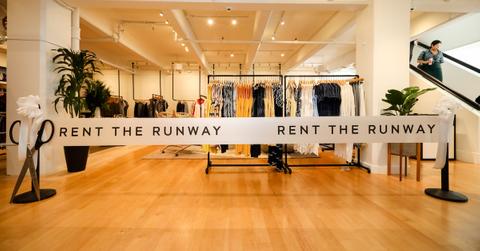New Study Says Renting Clothes Is Unsustainable — but It's Missing the Whole Picture
Published July 8 2021, 1:05 p.m. ET

While simply wearing the clothes already in your wardrobe is probably the most effective way to dress sustainably, there are many other ways that eco-conscious fashion lovers keep their closets low-impact. For example, there’s shopping secondhand, buying ethically-made garments, attending clothing swaps, and, as has become more popular in recent years, renting clothing.
However, a new study raising concerns about the sustainability of clothing rental models is giving avid clothing-renters pause, and leaving them wondering, is renting clothes sustainable?

A new study found that renting clothes is sometimes not as sustainable as it seems.
Finland-based journal Environmental Research Letters recently published a study analyzing the “global warming potential” of five “ownership and end-of-life scenarios” for clothing:
- Base: basic use of a new piece of clothing, and then throwing it away
- Reduce: extended use, such as wearing clothing over and over for years
- Reuse: re-selling clothes that are no longer needed
- Recycle: sending old clothes to be industrially recycled into new products
- Share: renting clothing from a clothing rental service, and then sending it back.
The study concluded that in general, the scenario with the lowest global warming potential was reducing, followed by reusing. Textile recycling had surprisingly high emissions (though it’s certainly better than “base,” aka throwing clothes away), but the authors found that borrowing clothing from rental services — when done on a large scale — actually had the highest global warming potential of the five scenarios.
While many people argue that renting clothes is sustainable, as it is a form of reuse, the study takes into account many aspects of large rental services’ supply chains, such as buying the garments, dry cleaning them between each rental, the packaging materials, and the transportation emissions. These certainly are important factors to look at — however, there are many factors that were not considered by the study’s authors.
Sustainable and ethical fashion blogger Venetia La Manna pointed out a few of these things in an Instagram post in response to the study. For one thing, the study did not consider the ethical implications of these five methods — but whether the clothes one is renting were produced ethically is a huge factor in terms of sustainability. Unethical labor and production methods are simply not something our society can sustain.
Additionally, La Manna noted that the rental portion of the study only focused on large rental companies that buy and keep large stocks of clothing (such as Rent the Runway, Nuuly, or Le Tote), as opposed to peer-to-peer models (like Wardrobe, Tulerie or RINS). The former business model tends to dominate the clothing rental market, and it certainly has a higher impact than the latter, as peer-to-peer models don’t require investing in stock.
“I don’t think anyone is suggesting that renting clothes is going to save us from climate breakdown, but I do worry that people will do the thing when they just read the article headline and think that ‘throwing away’ clothes can be considered even a tiny bit green,’” La Manna wrote. “Ultimately, we need to address our infatuation with newness and all trend based fashion businesses need to be extremely wary of the part they play in pedalling needless consumption.”
Why renting clothes can be a sustainable way to dress:
All that being said, supporting clothing rental businesses can still be a sustainable choice, especially if you need new outfits constantly for work or events — and certain clothing companies are more sustainable than others. As mentioned above, a peer-to-peer clothing rental can have a lower impact — as can one that messengers clothing locally, such as Wardrobe or Rent the Runway, which both do so in the New York City area.
Additionally, when renting clothes from larger subscription models, you can reduce the impact of each rental in a few ways, such as: opting to rent more items made by sustainable brands, wearing your rented items multiple times before sending them back to be cleaned, and choosing subscription services that operate locally.
Like any sustainability issue, that of renting clothing is complex, and every scenario is a bit different. If you want to keep the impact of your fashion habit as low as possible, the best thing you can do is rewear what you already have — and when you need or want something new, make the best choice you can, whether that be shopping secondhand, shopping from a sustainable and ethical brand, or renting.